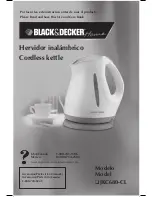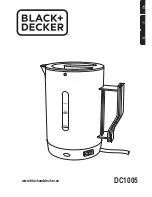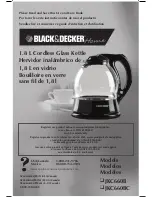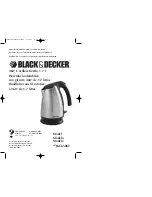
III. INSTRUCTIONS FOR USE
Before the first use, fill the electric kettle with clean water to the maximum level, turn it on and let
the water boil. Then pour out the water and repeat the procedure several times (at least five times).
APPLICATIONS
Open the lid
A5
by pressing the lock button
A6
. Fill the kettle with drinking water. Close the lid
by snapping. Put the electric kettle on the stand and turn it to the
I
position by the
A1
button.
Function of the electric kettle is signaled with the control light
A2
. After boiling the appliance
switches off automatically. Before reaching the boiling point, you can switch off the appliance by
turning the
A1
button to the
0
position.
ATTENTION
– When heating water, the lid must be closed, otherwise the kettle will not turn OFF.
– In bigger tilting of the electric kettle backwards, particularly when it is filled up to maximum,
water can flow out from the electric kettle in the bottom part of the kettle. This does not affect
safety or other functions and it does not mean any failure of the electric kettle. In the case
of tilting the electric kettle with hot water there is a risk of scalding. Therefore do not tilt the
electric kettle.
–
Recommendation: When the kettle is not used, do not place it on the stand connected to the
mains. If you are going not to use the kettle for a long time, unplug the power cord from the
wall socket.
– If the kettle was removed from the stand during boiling, remains in ON position.
This means that if you put it back on the stand, it will immediately continue in heating.
IV. MAINTENANCE
Unplug the appliance from power supply by taking the fork of the power cord out of the
socket! Clean the kettle only when it is cooled down! Do not use rough and aggressive
detergents (e.g. sharp objects, scrapers, diluting agents or other solvents)!
The casing
of the electric kettle is made of top-quality glass and the heating bottom is made of top-quality
stainless steel, but in common use, impurities from water get stuck on them (water scale),
particularly above the heating element.
It is not rust or another material defect of the kettle
container and the appliance is not subject to a complaint for this reason.
Cleaning the kettle
In the hard water area, it is important to do the decalcification regularly to keep the kettle in good
working condition, because too much scale inside may cause the kettle fail to work. For the best
performance of your kettle, decalcify the unit from time to time. The frequency depends on the
hardness of your tap water and how many times you have used the kettle. Decalcification will
clean the interior of the unit.
This may be done in the following manner:
Put about 50 g of citric acid into the kettle with limescale sediment. Fill the kettle half with water
and stir. After dissolving, fill it up to ¾ of maximum amount of water. Place the kettle on the
stand and turn on. Turn off the kettle before reaching boiling point, let the solution work for 10
minutes and then pour it out. Rinse the kettle thoroughly with clean water. In case of very thick
sediments, you can repeat the process. Clean the kettle regularly!
GB
17 / 22
Summary of Contents for VK 101
Page 2: ...A 1 2 3 4 A3 A2 A4 A1 A5 A6 A7 B B1 B2 1...
Page 27: ......












































